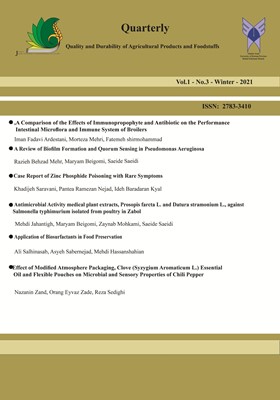Antimicrobial Activity medical plant extracts, Prosopis farcta L. and Datura stramonium L., against Salmonella thyphimurium isolated from poultry in Zabol
Subject Areas : Shelf Life of Food Products and Agricultural Productionsmehdi jahantigh 1 , Maryam Beigomi 2 , Zaynab Mohkami 3 , saeide saeidi 4
1 - Associate Professor, Clinical Pathology, Department of Clinical Sciences, Faculty of Veterinary Medicine, University of Zabol, Zabol, Iran
2 - Assistant Professor, Nutritional Sciences & Food Technology, School of Medicine, Zahedan University of Medical Sciences, Zahedan, Iran
3 - Assistant Professor, Department of Agriculture and Plant Breeding, Nstitute of Agricultural Research, University of Zabol, Zabol, Iran
4 - M.S, Agricultural Biotechnology Institute, University of Zabol, Zabol, Iran
Keywords: Antimicrobial Activity, Minimum inhibitory concentration (MIC), Minimum bactericidal Concentration (MBC), Syrian mesquite,
Abstract :
The aim of this study was to investigate the antimicrobial activity of Prosopis farcta L. and Datura stramonium L. extracts on Salmonella thyphimurium isolated from poultry in Zabol. The P. farcta and D. stramonium were collected from Collection of medicinal plants, Institute of Agricultural Research at University of Zabol. Strains of Salmonella thyphimurium were isolated from poultry droppings. Antibiotic resistance pattern was determined by Kirby Bauer method. Finally, the minimum inhibitory concentration (MIC) and minimum bactericide concentration (MBC) were determined by microdilution method. The results of this study showed that the lowest inhibitory concentration of Datura extract against Salmonella typhimurium was 3.1 ppm; While the minimum inhibitory concentration for Prosopis extract was 6.5 ppm. Also, the minimum bactericidal concentration of Datura extract was 6.25 and Prosopis extract was 12.5. The results of this study showed that Datura extract was more effective in inhibiting Salmonella bacteria than Prosopis extract. Evaluation of Pearson correlation coefficient between total phenol content, total flavonoids and MIC, and MBC showed an inverse relationship between these parameters. So that the Datura extract, which contained higher total phenol, and total flavonoid, had lower MIC and MBC and therefore was more effective in inhibiting bacteria. The results of our experiments showed that Datura and Prosopis extracts have good antimicrobial effects and can be used to treat infections caused by Salmonella typhimurium in poultry.
1- Zahraei Salehi T. Salmonella. First edi-tion, University of Tehran. 2008;101-188. [In Persian]
2- Saad B, Azaizeh H, Said O. Tradition and perspctives of arab herbal medicine. A review. Evidence-Based Complementary and Alternative Medicine. 2005;2(4):475-9.
3- Jawad AM, Jaffer HJ, Alnaib A, Naji A. Antimicrobial activity of Sesquiterpene la-ctone and alkaloid fractions from Iraqi-plants. International Journal of Crude Drug Research. 1988;26:185-188.
4- Ranjbar Heidari A, Khayyat-Zadeh J, Keshtahgar M. Study of root aqueous ext-ract of Prosopis farcta effect on wound healing of diabetic adult male rats. Journal of Birjand University of Medical Sciences. 2012;19 (3):245-254.
5- Al-Qura'n S. Taxonomical and pharma-cological survey of therapeutic plants in Jordan. Journal of Natural Products. 2008; 1:10-26.
6- Jarald E, Balakrishnan Joshi S, Chandra Jain D. Diabetes VS Herbal Medicines. Iranian Journal of Pharmacology and thera-peutics. 2008;7(1):97-106.
7- Khan FM. Ethno-Veterinary medicinal usage of flora of greater cholista desert (Pakistan). Pakistan Veterinary Journal. 2009;29(2):75-80.
8- Soni P, Siddiqui AA, Dwivedi J, Soni V. Pharmacological properties of Datura stramonium L. as a potential medicinal tree: An overview. Asian Pacific journal of tropical biomedicine. 2012;2(12):1002-08.
9- Velmurugan S, Viji VT, Babu MM, Punitha MJ, Citarasu T. Antimicrobial effect of Calotropis procera active prin-ciples against aquatic microbial pathogens isolated from shrimp and fishes. Asian Pacific Journal of Tropical Biomedical. 2012;2:812-817.
10- Mashayekhi K, Atashi S. The analy-zing methods in plant physiology. Tak. 2015:310. [In Persian]
11- Sanchooli N, Rigi M. The effects of plant extracts Prosopis fraca, Datura stram-unium and Calotropis procera against three species of fish pathogenic bacteria. Journal of Veterinary Research. 2015;70(4):455-462. [In Persian]
12- MustafaSazan K, Maulud Pshteewan Q, Hamad A. Detection of Sphingomonas paucimobilis and antibacterial activity of Prosopis farcta extracts on it. Karbala International Journal of Modern Science. 2018;4(1):100-106.
13- Sharifi Rad J, Hoseini-Alfatemi SM, Sharifi-Rad M, Miri A. Phytochemical screening and antibacterial activity of Prosopis farcta different parts extracts against methicillin-resistant Staphylococ-cus aureus (MRSA). Minerva Biotecnolo-gica. 2014;26:287-93.
14- Al-Sorchee SMA, Rabat AAK, Juma IM. The effect of extract plants on the causative agents of diarrhoea in children of erbil Kurdistan Iraq. midd Erbil Kurdistan Iraq. 2010;8:1-9.
15- Gul H, Qaisrani RN, Ayaz Khan M, Hassan Sh, Younis N. Antibacterial and antifungal activity of different extracts of Datura stramonium (branches and leaves sample). Journal of Biotechnology and Pharmaceutical Research. 2012;3:141-148.
16- Eftekhar F, Yousefzadi M, Tafakori V. Antimicrobial activity of Datura innoxia and Datura stramonium. Fitoterapia. 2005; 76(1):118-20.
17- Waza SA, Anthony P, Dar S. Phytochemical Analysis, Antioxidant and Antimicrobial Activities of Methanolic Ex-tract of Datura Stramonium Seeds. Interna-tional Journal of Pharmaceutical Sciences and Research. 2015;6(7):3021-26.
18- Shobha G, Soumya C, Shashidhara KS, Moses V. Phytochemical profile antibacte-rial and antidiabetic effects of crude aqu-eous leaf extract of datura stramonium. Pharmacophore. 2014;5(2):273-278.
19- Asadpour Y, Mohammadi M, Pourbak-hsh SA, Rasa M. Isolation, serotyping and antibiotic resistance of Salmonella isolated from chicken carcasses in Guilan province. Iranian Veterinary Journal. 2014;9(4):5-13. [In Persian]
20- Namroodi S, Estaji H, Dehmordeh M. Frequency and antimicrobial resistance pattern of salmonella spp in asymptomatic rural dogs. Journal of Mazandaran Univer-sity of Medical Sciences. 2016;26(135): 153-157. [In Persian]
_||_

